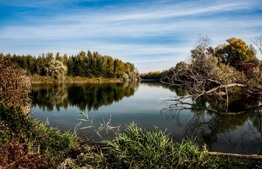Parashat Matot-Masei: Stop! Border Ahead

The Land of Israel has not one but three (!) sets of borders, each indicating different levels of holiness with practical halachic ramifications. On the role of borders and halacha plus a survey of the southernmost border: Nachal Mitzrayim.
One Land — Three Sets of Boundaries
There’s something intimidating about boundaries, something very stifling and confining. Even if it’s not a high partition barrier covered by barbed wire, surrounded by intrusion-tracking dirt roads, and covered in electronic sensors meant to prevent trespassing. Even if a boundary isn’t marked in territory, there is still that limiting sense of confinement.
The Land of Israel’s borders mentioned in this week’s parasha are not the only set of boundaries described by the Torah. When Hashem promised the Land of Israel to Avraham Avinu, He didn’t leave the promise amorphous; rather Hashem provides a detailed list of boundaries, much more expansive that the ones mentioned in our parasha. The boundaries of the brit bein habetarim are called gevulot hahavtacha, “boundaries of the promise.” But if you thought that with this week’s list of borders we are done, we have another set of even narrower boundaries. The borders described in our parasha relate to the region that would be conquered by the Israelites who left Egypt, which is why they are called the borders of olei Mitzrayim. However, the most constricted boundaries, which carry with them the greatest degree of halachic importance today (while the other borders also have relevant halachic importance), is the boundaries of olei Bavel, which, as the Rambam writes (Hilchot Terumot 1:5), will always retain their sanctity.
Down the line (and due to our prolonged exile), the identities of part of the border markers were forgotten. This gave rise to disputes from the times of the Rishonim until today, with all parties attempting to decipher the landmarks mentioned by the Biblical and Talmudic sources.
This all begs the question: what is the big deal with extensive, exhausting discussion and identification of Israel’s boundaries, and who needs them anyway?
The Wisdom of Boundaries: Halacha
It seems that Hashem wants to teach us here a profound idea that relates not only to geographical borders, but all boundaries in general.
The wisdom of kabbalah teaches us that every person and object possesses a spark of holiness that gives it life. Even evil possesses this spark of holiness, otherwise it would cease to exist. Does this mean that evil is good? Of course not. Through the lens of kabbalah, one can see G-dliness in everything, but we know that in this world there is much evil that hides the good.
This highlights the importance of studying boundaries. The halacha is, in essence, a clarification of the definitions of permitted and forbidden, of obligation and exemption, and of purity and impurity. Studying internal wisdom (kabbalah) alone can be very misleading. Since in the future pork will be kosher, can someone who eats pork today be considered as if they are living already in the future, utopian world? Of course not! On the contrary, this indicates that the person is currently very far from being in any sort of spiritual utopia.
Even the Ari z”l (R’ Yitzchak Luria, whose yahrzeit is 5 Av), a kabalistic giant by all counts, engaged extensively in the “revealed wisdom” as a disciple of Rabbi Betzalel Ashkenazi. The Ari even assisted his master in editing the Shita Mekubetzet, R’ Betzalel Ashkenazi’s commentary on the shas. The Ari viewed the study of halacha as a most lofty pursuit. There are accounts that the Ari would toil and sweat over resolving intricate halachic issues with his disciples as part of their lofty work of spiritual clarification.
Differentiation Depends on Knowledge
The ability to discern between the sacred and the profane is one of the unique abilities of mankind,
G-d’s most lofty creation. “ואם אין דעת – הבדלה מניין” “And if there is no knowledge, how can one differentiate?” One’s understanding of the general holiness that exists in the world must not interfere with our unique job in this world to discern between the sacred and the profane, the pure and the impure. While it is important to recognize the sanctity that exists within the profane, it is much more important and urgent to see and understand that there is huge chasm separating between the sacred and the profane, and of course the pure and the impure.
Even today people unfortunately miss this critical point; in earlier generations, this happened with the false messiahs who transgressed severe prohibitions to “repair” these sins on a spiritual level, as they claimed. We can assume that they even believed that they were doing the right thing, but this doesn’t change the fact that they sowed spiritual devastation by their actions.
Even within the world of sanctity, there are different levels. On the time continuum, there are weekdays (in Hebrew: yemot hachol, lit. “profane days”), there is chol hamoed, holidays, Shabbat, and Yom Kippur. So too, there are levels of holiness on a geographical level: the ten levels of holiness delineated in the first chapter of tractate Keilim, and the different sets of borders of the Land of Israel. The differentiation between the sacred and even more sacred is also extremely important.
The study of borders should not intimidate us. This is, after all, our primary purpose in this world. Since Adam’s primal sin, good and evil mixed together, so it is our job to differentiate between the two. The primary means towards this differentiation is by learning about borders, that is, by studying halacha.
The Southernmost Border of Olei Mitzrayim: Nachal Mitzrayim
Written Torah Explaining the Oral Torah
We are used to the Oral Torah, explaining the Written Torah; indeed, this is one of its primary functions. However, there are instances where the Oral Torah begs explanation. One of these cases is the topic of the Land of Israel's boundaries. The Mishnayot that deal with the Land of Israel's boundaries refers to shemita and challah (Shevi'it 6:1, Challah 4:8, respectively) are very complex and difficult to understand. In this context, the borders mentioned in parashat Masei, even if it is not always possible to identify them with certainty, they are clearer, and it can be used to explain at least the second boundary mentioned in the Mishna: the borders of olei Mitzrayim.
This time we will discuss the southern-most border, which the Mishna does not discuss (at least on face value; the Rambam identifies the river mentioned in the Mishna not as the Nahar HaTzefoni, but rather as Nachal Mitzrayim). The description of the southern border from east to west, as it appears in the Torah: the Sin Desert adjacent to Edom, the southernmost tip of the Dead Sea, south of Ma'aleh Akrabim, Sin, Kadesh Barne'a, Chatzar Adar, Atzmon, Nachal Mitzrayim (lit. "the brook/river of Egypt"), and the Mediterranean Sea.
Pelusium
Going back to the Rishonim, there are two opinions on the identity of Nachal Mitzrayim. One school of thought (following Targum Yonatan and the Targum Yerushalmi on our parasha) maintains that this is the eastern branch of the Nile River (also termed the Pelusian branch of the Nile Delta) which no longer exists today; it is the approximate location of the Suez Canal is situated, since the 19th century. According to this opinion, this border not only separated the Land of Israel and countries abroad, but it also divides Asia and Africa. The ancient city Pelusium was situated nearby, northeast of the Sinai Peninsula. The Targum Yerushalmi, renders the city Ra'amses (one of the cities the enslaved Hebrews built in Egypt) as "Polonsin" (close to the Greek term for the city, "Pelousion").
The fact that the city was located on the Nile bank in close proximity to the Mediterranean Sea made Pelusium an important port city. From the 1st Century CE, the city began to fill with drift and the beach became farther and farther away from the city. Pelusium was famous for its linen, called Pelusium linen. On Yom Kippur, the High Priest would wear this very linen, termed "pilosin."
The city's location made it a site of critical battles. In 1117, Pelusium was captured by the Crusaders. The Crusaders razed the city to the ground, and thereafter it nearly disappeared from history. The name of the region was preserved with the Arabic mispronunciation "Beloza," which became of focal point of battles between Egypt and the IDF during the Six Day War, the War of Attrition, and the Yom Kippur War.
Wadi el-Arish
Another school of thought (Kaftor Vaferach, based on R. Sa'adia Gaon; the Radbaz and others), identifies Nachal Mitzrayim with another important river in northeast Sinai: Wadi el-Arish, some 300 km long, and up to 50 km wide at certain areas. At its estuary, where it meets the Mediterranean, it is one kilometer wide. Although it is a seasonal stream, when full it can cause dangerous flash floods, even taking lives In 2010 dozens of el-Arish residents were killed and wounded, and hundreds of homes drifted away in such a flash flood. In its wake, thousands of Bedouin burned down an Egyptian police station claiming that they failed to provide rescue aid.
The city of el-Arish, adjacent to the estuary, was founded around a Pharaonic citadel. "Arish" means "palm huts," which could link the area to Sukkot, one of the waystations on the Israelites' journey mentioned in our parasha. Some identify el-Arish with Rhinocorura, Herod's city of refuge when fleeing from the last Hasmonean king, Antigonus (Matityahu) II. It was here, too, that Titus stationed his troops on his way from Alexandria to Jerusalem.
One of the first proposals to the Zionist movement for a Jewish homeland was el-Arish, or "the Egyptian Land of Israel," as it was then called. However, the Zionist request to divert Nile water provided the British governor of Egypt with an excuse to withdraw from the plan.
Following the liberation of the Sinai Peninsula in the Six Day War, Nachal (a youth IDF group) set up an outpost approximately 5 km northeast of el-Arish. The military outpost was later populated by civilians and became Neot Sinai. El-Arish was relinquished to Egypt as part of the Camp David Accords, along with Neot Sinai. It was in the Neot Sinai vegetable fields that hundreds of settlers fortified themselves when being forcibly evicted by the IDF.
By 5742 (1982), the Sinai Peninsula was completely evacuated and handed over to Egypt, after the destruction of Yamit, a nine-year-old town. It is noteworthy that both Yamit (including Neot Sinai) and Gush Katif, according to both opinions in the identification of the Land of Israel's boundaries, are undoubtedly integral parts of the Land of Israel. May it be G-d's will that we return to our borders speedily and in our days.




